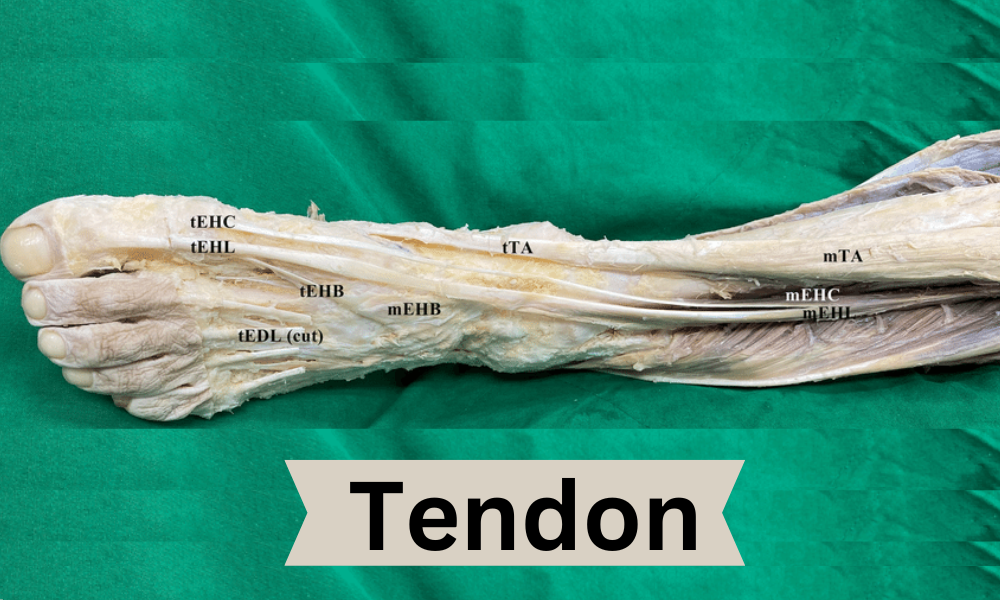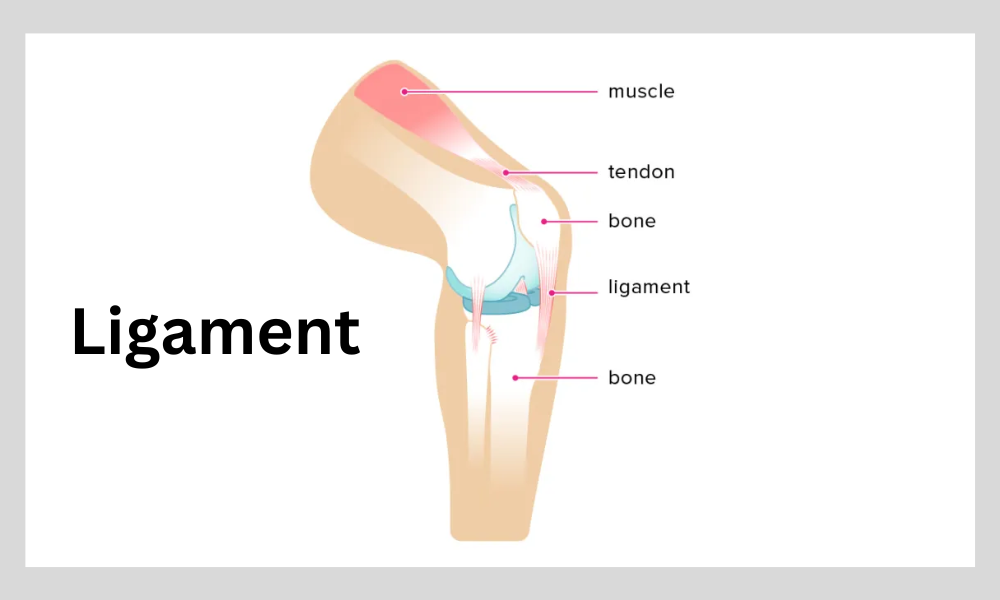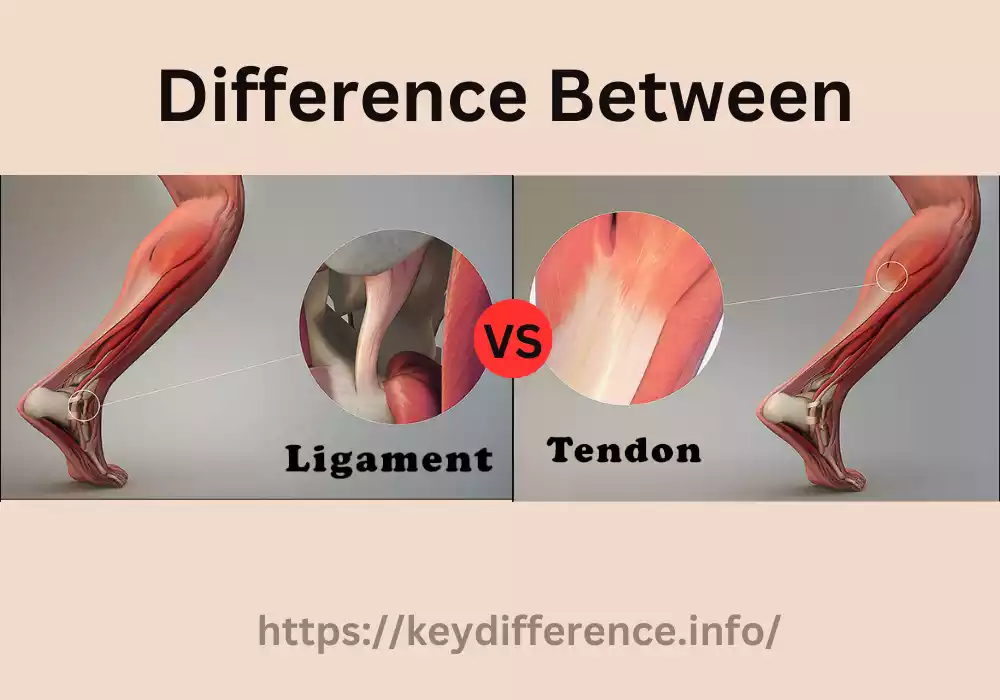Tendon and Ligament
The ligaments and the tendon are two connective tissues of the human body that have distinct roles. Tendons link bones to muscles to allow movement as well as transmit force during the contraction of muscles. They’re made up of parallel collagen fibers offering durability and stability.
In contrast, they connect bone to bones, stabilizing joints and stopping excessive movement. The ligaments have a more complex configuration of collagen fibers permitting flexibility and even controlled mobility. Knowing the distinctions between tendons and ligaments are essential to diagnose and treat injuries with precision. Tendon-related injuries like tendonitis, tears or strains require specialized treatment, whereas ligament injuries like tears and sprains have various treatment methods.
Tendon meaning

Tendons are tough fibrous connective tissue that connects bone and muscle. It’s composed of collagen fibers with cells as well as the gel-like substance that is used as a ground. Tendons are a key component in the musculoskeletal system, transducing the forces produced through muscle contractions to bones.
They allow movement while stabilizing joints. Tendons typically are located on the muscles’ ends and play a role in transferring the contraction force generated by muscles to bone. They allow for a variety of movements and movements. They possess a strong and parallel array of collagen fibers which gives the muscles strength and resists tension. Tendons are essential to ensure proper function and coordination of the muscle and skeletal systems of the body.
Ligament meaning

The ligament is a tough connective tissue, which is fibrous and connects bone and bone. It provides stabilization and support for joints. It’s composed of collagen fibers with cells and an emulsion-like ground substance. Ligaments play an important part in maintaining the integrity and alignment of joints, by restricting excess movement and thus avoiding the possibility of instability or dislocation.
They’re situated around joints and play a role in stabilizing the bones by allowing for controlled movement as well as giving resistance to an external force. Ligaments feature a much more elaborate arrangement of collagen fibers in comparison with tendons. This allows them to resist forces coming in multiple directions, and ensure the joint’s stability. They also play an important role in joint proprioception by providing the joint with sensory information and assisting in overall body coordination and balance.
Structure and Composition
A. Tendon
Tendons are characterized by particular structure and composition which contributes to their purpose:
The definition and the location: Tendons are connective tissue that is dense that joins bone and muscle. They’re located near the end of muscles which is where they join into fibrous connective tissue which attaches to bone.
Composition:
- Tendons made of collagen fibers consist primarily of collagen. It provides durability and flexibility. Collagen fibers are organized into parallel bundles, which allow the tendons to endure the tensile force of high tension.
- Cells: Tendons are stocked with special cells known as tenocytes that produce and sustain collagen fibers.
- A grounding substance. Tendons also contain an emulsion-like substance called a ground which surrounds collagen fibers and provides the lubrication needed and also assistance.
Function: The structure of the tendons allows them to transmit the forces of muscle to bone by allowing movement, and ensuring the joint’s stability. The parallel structure of collagen fibers permits the tendons to withstand tension as well as transfer contractional forces produced by muscles onto bones.
B. Ligament
Ligaments have distinctive shape and structure that contributes to their contribution to joint stability
Location and definition: Ligaments are connective tissues made of fibrous that link bone to bone. They can be found in joints, securing the bones in place and providing stability.
Composition:
- The collagen fibers in ligaments consist primarily of collagen fibers. They are as are the tendons. But, the arrangement of collagen fibers found in ligaments is more complicated and forms a crisscross or wave pattern. This pattern provides ligaments with durability and strength in multiple directions.
- Cells: Similar to tendons, ligaments are home to fibroblasts, cells that produce and sustain collagen fibers.
- A grounding substance Ligaments have the appearance of a gel that is surrounded by collagen fibers and provides the flexibility and support.
Structure: The form of ligaments and their complicated configuration of collagen fibers can stabilize joints by stopping excessive movement. Ligaments reduce tension and to maintain proper position of bones, which contributes to joint stability and stopping the dislocation of joints.
The function of Tendon and Ligament
- Tendon
Tendons have numerous important functions and roles within the body:
- Transferring forces from muscles to bone. Tendons join muscles with bones. They are the ones responsible for transmitting force generated by contractions of muscles to bones, which allows motion and supporting actions like running, walking as well as lifting.
- Allowing joint movement and stability. By connecting joints to muscles, tendons play an essential role in facilitating the coordinated motion of body components. They offer stability to joints and help maintain the bones in alignment during movements.
- Storage and absorption of energy during physical exercise. Tendons are characterized by elastic properties which allow them to store and absorb the energy created by contractions of muscles. The stored energy is released when you move, thereby improving efficiency and speed.
- Ligament
Ligaments also perform important roles and functions that are related to joint stability as well as mobility:
- Stabilizing joints Ligaments link bone and bone, and play an important function in stabilizing joints. They assist in maintaining the appropriate bone alignment and also prevent the movement of joints that may cause dislocation or joint instability.
- Stopping excessive joint movements Ligaments serve as physical restraints by restricting the range of motion for joints as well as preventing excessive motion. They are able to withstand external forces and protect joints from injury.
- Supporting joint proprioception Ligaments are a source of sensory receptors, which contribute to joint proprioception. This is the body’s sense of the movement and position of joints. Proprioceptive feedback aids to maintain the balance, coordination, and overall control of the body.
In the end, tendons transfer force from muscles to bone. They also allow for movement and also store energy. Likewise, ligaments support joints, prevent the excessive movement of joints, and also help with joint proprioception.
Injuries of tendon and ligament
The muscles and ligaments are vulnerable to damage. are often the result of various reasons, like injuries, excessive use repeated stress, and changes in the structure.
Below are the most frequently occurring traumas that could be caused by ligaments or tendons:
Tendon Injury:
- Tendonitis: Tendonitis refers to an inflammation of the tendons. The most common cause is the repetition of motions, use, and aging. Tendonitis is a common condition.
- Tendinosis: Tendinosis is a chronic disease that is characterized by the disintegration of the tendon but without any significant inflammation. It’s usually caused by repetitive strain or overuse that could result in tendon thickening as well as pain and decreased functioning.
- Tendon tears or ruptures: Tendon tears and ruptures may occur as a result of trauma to the body or a change in the generative system. Examples include rotator-cuff tears on the shoulder the rupture of the quadriceps tendon at the knee, as well as Achilles tendon tears.
Ligament Injury:
- Sprains: Ligament sprains can occur when ligaments are stretched or torn because of sudden twisting, hyperextension, or injury. The most frequent sprains are ankle sprains and knee ligament strains (such as ACL, MCL, or LCL strains) as well as wrist strains.
- Joint Dislocation: A severe injury or force that is applied to joints can result in ligament injuries as well as joint displacement. The joints’ bones are totally displaced from their usual place. It is important to remember the degree of ligament and tendon injuries may vary from mild inflammation to total ruptures or tears. It can be accompanied by the following: swelling, pain, instability or joint stiffness, and diminished movement. The diagnosis usually involves a physical exam and diagnostic tests (such as X-rays MRI or ultrasound) or, in some cases injecting diagnostically.
- Treatment for tendon and ligament: injuries is dependent on several aspects, which include the place and severity of injuries, in addition to the condition of the patient and their fitness. Alternative treatments for non-surgical injuries could consist of rest, immobilization through braces or splints as well as physical therapy, pain management, and anti-inflammatory medicines. If you suffer from more severe injuries or those that are complex the need for surgery could be needed to fix or replace the injured ligaments and tendons.
It is essential to speak an expert in healthcare for the most accurate diagnosis and a treatment program that is tailored to your specific injuries and personal circumstances. Proper and timely treatment of ligament and tendon injuries can assist in the process of healing, lessening discomfort, increasing function, and avoiding long-term problems.
Treatment of Tendon and Ligament
The treatment of ligament and tendon injuries usually involves an array of conservative measures and, in some instances surgical intervention.
Here are a few common treatments:
A Conservative Approach to Treatment
- Rest and immobilization: In the case of an injury, resting it and preventing it from being able to move using a brace, splint or a cast can protect the ligament or tendon from further injury, and also allows to begin the first phases of healing.
- Physical Therapy: Physical therapy plays an essential role in ligament and tendon healing. It involves stretching, exercises as well as manual techniques to aid in healing, improve strength and flexibility, joint stability, as well as enhance overall functioning.
- Modalities: Therapeutic modalities such as heat or ice therapy or electrical stimulation, ultrasound, or laser therapy can be employed to relieve inflammation, ease pain and aid in healing.
- Orthotic Devices: Based on the site the orthotic device such as braces, splints, or orthopedic shoes may be suggested to help provide stability, support, and proper alignment throughout recovery.
The Surgical Treatment:
- Tendon/Ligament repair: In cases of severe tears or complete injuries that are not responding to treatment with a conservative approach surgical repair is needed. In the course of the operation, tears at the edges of the ligament or tendon are repaired by anchors or sutures.
- Tendon/Ligament Reconstruction: In cases where the ligament or tendon is severely damaged or can’t be repaired, reconstruction can be accomplished with autografts (tissue taken from the patient’s body) as well as allografts (tissue from donors) to repair tissues damaged by injury.
Clinical significance of tendon and ligament tissue damage
Damage to ligaments and tendons could have serious clinical consequences and should be treated accordingly.
Here are some of the medical implications of tendon and ligament tissue injuries:
- Impaired Function: Tendon or ligament injuries may cause discomfort, weakness as well as restricted mobility, leading to impairment in performance. The result can be a hindrance to everyday activities, athletic performance as well as work-related activities, affecting the overall level of living.
- Increased mobility: Tendon or ligament injury can affect joint flexibility and mobility. It can affect the ability to carry out certain tasks that affect joint functionality.
- Joint Instability: In extreme situations, ligaments and tendon injuries could lead to joint instability. Instabilities occur when the supporting structure around the joint is damaged, which makes joints susceptible to deviations in movement, subluxation or dislocation. The instability could increase the possibility of sustaining a further injury and can affect the joint’s functionality.
- Chronic Pain: Incorrectly treated or improperly managed ligament and tendon injuries could cause long-term pain. The tissues that have been damaged may not fully heal which can cause persistent discomfort and pain following the initial period of injury has been resolved.
- Problems with Rehabilitation: Rehabilitating ligament and tendon injuries could be challenging because of the slow healing process of these tissues, as well as the requirement for carefully planned exercise routines. The proper treatment is vital for restoring flexibility, strength, and sturdiness in the affected area.
- Surgical Intervention: Extreme ligament and tendon injuries could necessitate surgical intervention to fix or replace the injured tissues. Surgery is not without risk and will require a complete rehabilitation plan to maximize healing.
- Tendon or ligament injuries: It could make it more likely for future injuries. When these structures have been damaged, they are more vulnerable to injuries recurring particularly if appropriate rehabilitation, strength, and preventative measures aren’t implemented.
A proper diagnosis, treatment, and rehabilitation under the supervision by healthcare professionals is essential in addressing the injury to ligaments and tendons efficiently. Early intervention, appropriate relaxation, specific exercises, techniques, and a gradual return back to work are essential aspects of recovery that aim at recovering functionality, lessening pain, and decreasing the chance of developing long-term problems.
Comparison Table of Tendons and Ligaments
Here’s a comparison chart highlighting the key differences between tendons and ligaments:
| Aspect | Tendons | Ligaments |
|---|---|---|
| Location | Found at the ends of muscles | Found in and around joints |
| Attachment | Connects muscle to bone | Connects bone to bone |
| Structure | Dense collagen fibers aligned in parallel | Dense collagen fibers arranged in a crisscross or wavy pattern |
| Function | Transmits forces from muscle to bone | Provides stability to joints |
| Mobility | Less mobile due to limited elasticity | Allows controlled movement within joint’s normal range of motion |
| Primary Role | Transmitting forces during muscle contractions | Stabilizing joints |
| Elasticity | Limited elasticity | Moderate elasticity |
| Injury Examples | Tendonitis, tendon tears or ruptures | Sprains, ligament tears |
| Treatment Approach | Rest, physical therapy, and sometimes surgery | Rest, physical therapy, and sometimes surgery |
Conclusion
Knowing the differences between ligaments and tendons is vital to recognize their different roles, functions as well as structures within the body. Tendons join bones and muscles and transfer forces created through muscle contractions. They allow flexibility as well as joint stability. Ligaments on the other side, link bone and bone, providing stabilization to joints, by stopping the movement of joints.
Tendons consist of collagen fibers that align in the direction of parallels, while ligaments are made up of collagen fibers that are arranged in more complex patterns. Tendons are unable to move and have low elasticity, with a focus on the transmission of force, whereas ligaments exhibit moderate elasticity that allows for control of movement within a joint’s normal range of motion.

